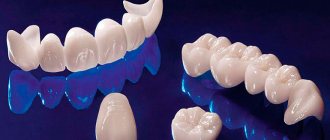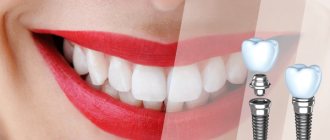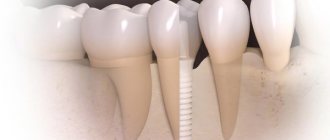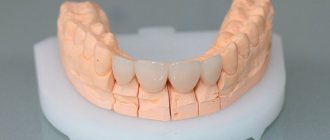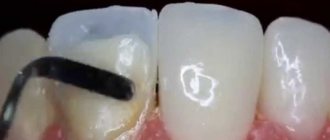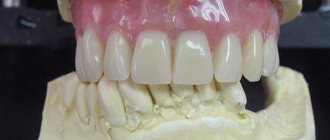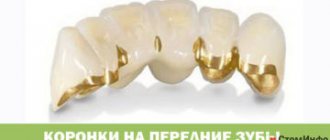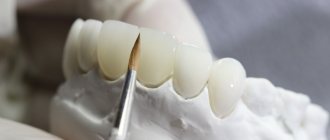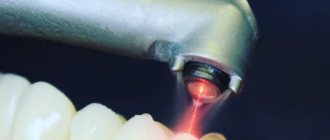From this article you will learn:
- zirconium dioxide crowns: pros and cons,
- their varieties, before and after photos,
- how much does a zirconium crown cost in 2020?
Zirconium crowns are a variant of dental crowns for restoring damaged and missing teeth, the material of which is zirconium dioxide (ZrO2). This material belongs to metal-free ceramics. Unlike metal-ceramics, zirconium dioxide crowns do not have a metal frame inside, which makes it possible to achieve a higher level of aesthetics in dental prosthetics (compared to metal-ceramic crowns).
Zirconium crowns also have very high strength. They are considered to be at least 2-4 times stronger than crowns made from other types of metal-free ceramics (for example, porcelain crowns). But all this is true only for crowns that are made of monolithic zirconium dioxide. In most cases, only the internal frame is milled from zirconium dioxide, on top of which layers of porcelain mass are applied. This allows you to achieve a higher level of aesthetics, but on the other hand, it increases the risk of chipping.
Zirconium crowns: photo
Thus, making crowns from zirconium dioxide allows you to make them look more like real teeth (compared to metal-ceramics). However, to be objective, the aesthetics of zirconium crowns in most cases will still be inferior to some other types of metal-free ceramics, for example, crowns made of feldspathic porcelain or IPS E-max ceramics.
In this article we will talk not only about the pros, but also about the disadvantages of ceramic crowns made of zirconium dioxide, and also why reviews of zirconium dental crowns from real patients are very often negative. For example, a lot depends on the initial characteristics and quality of the zirconium dioxide blocks from which the crowns are milled on a computer-controlled machine. But the cost of good material is very high, and many clinics purchase cheap material.
Zirconium crowns - their types, manufacturing technology
The production of zirconium crowns occurs using CAD/CAM technology, requiring very expensive equipment. This technology implies that crowns are made by milling zirconium dioxide blocks (Fig. 4). This happens on a computer-controlled machine, i.e. with virtually no human intervention at all.
Milling zirconium crowns (animation + video) –
There are 2 types of zirconium crowns:
- Classic zirconium crowns (Fig. 4) –
Such crowns consist of two layers. Inside, they have a frame milled from zirconium dioxide, which is then lined with layers of porcelain. The zirconium frame makes the crown durable, and the porcelain mass on its surface allows the crown to have good aesthetics.
- Monolithic zirconium crowns (Fig. 5) –
they consist of solid zirconia and do not have a porcelain layer on the surface. They are made less frequently and mainly only in the area of chewing teeth, which is due to the poorer aesthetics of monolithic zirconium crowns. However, such crowns also have a number of advantages, which you can read about below.
CAD/CAM production of zirconium crowns –
After the teeth are ground down for crowns, a three-dimensional model of the patient’s teeth is created on a computer using a special intraoral digital scanner (Fig. 6). Based on this model, the doctor uses a special computer program to calculate the size and shape of future crowns and creates a three-dimensional model of them (Fig. 7). It is at this stage that the doctor can plan the production of either a monolithic zirconium crown, or the production of only a zirconium crown frame, which will subsequently be lined with porcelain.
Next, the three-dimensional model of the crowns or their zirconium frame is transferred to a computer-controlled milling machine, where the actual process of milling zirconium dioxide blocks occurs (Fig. 8). After milling is completed, the finished structure is fired in a special furnace at high temperature - due to which the zirconium dioxide acquires the strength of the metal. If we are talking about the manufacture of traditional zirconium crowns, then layers of porcelain mass are then applied to the hardened zirconium frame (Fig. 9-11) - after which they are baked again in an oven at high temperature.
CAD/CAM technology for manufacturing zirconium crowns –
Zirconium frame and porcelain lining –
Monolithic zirconium crowns –
While for traditional zirconium crowns only the frame is milled from zirconium dioxide, monolithic zirconium crowns are made entirely of zirconium. Therefore, immediately after milling, they will already have a finished shape, and will not have a layer of porcelain on the surface. The weak point of monolithic crowns is aesthetics - after all, a layer of porcelain on the surface of the crown allows you to improve its aesthetic properties (imitates the translucency of natural tooth enamel).
Regular zirconia blocks have a bright milky color and are not transparent, so monolithic crowns made from this material will not look like real teeth. However, in recent years, some manufacturers have begun to produce translucent zirconia blocks (for example, Prettau® Anterior), which still allow the production of monolithic zirconia crowns with fairly acceptable esthetics.
It must be said that the absence of porcelain mass on the surface of a zirconium crown also has positive qualities. The weak point of zirconium crowns is the connection boundary between the zirconium frame and the porcelain layer. Studies have shown that the strength of the porcelain coating is only about 80-100 MPa, while the strength of the zirconium frame itself is more than 1000 MPa. In addition, aging crowns and the use of dyes lead to a subsequent deterioration of the bond between the zirconia and porcelain, which increases the risk of chipping.
Structure care
Zirconium dioxide structures do not require special care. It is enough for a person to carry out standard hygiene procedures: brushing teeth twice a day, using dental floss and rinsing balms after meals. It is not recommended to use highly abrasive toothpaste. To increase cleaning efficiency, you can use special miniature brushes that are designed to remove food debris from hard-to-reach places. It is recommended to visit a dentist every six months for a preventive examination. The service life of this structure is about 10-15 years.
Zirconium crowns: before and after photos
Below we present the most successful options for prosthetics of front teeth with zirconium crowns. However, to be objective, in most cases the aesthetic result will be worse than in photos 12-19. Even lower in the article we will also show the traditional “quality” of zirconium crowns on the front teeth, which you can find most often (24stoma.ru).
Clinical case No. 1 –
Clinical case No. 2 –
Clinical case No. 3 –
Clinical case No. 4 –
Types of zirconium crowns for front teeth
There are two types of zirconium crowns:
- prostheses made entirely of zirconium;
- designs that combine a zirconium base and a ceramic coating.
The second type is preferably installed on the anterior dental units.
Such crowns have higher aesthetic values. To achieve the desired shade, laboratory workers paint the crown and add shine and shadow to artificial enamel. Important! By choosing crowns with a zirconium frame coated with a thin layer of ceramic, you can avoid an unnatural smile.
Zirconium dioxide crowns: expert reviews
On the websites of dental clinics and during consultations, you will probably come across the fact that zirconium crowns will be strongly recommended to you. Over the years of using these crowns in practice, we have developed a list of optimal clinical situations in which these crowns would actually be a good choice. If you want perfect aesthetics, then in most cases we do not recommend doing them on the front teeth.
Optimal indications for zirconium crowns –
- bridges on chewing teeth,
- bridges on the front teeth (provided that the bridge consists of 4 or more crowns),
- single crowns and bridges on implants,
- in the presence of bruxism (monolithic zirconium crowns only).
When should you not make zirconium crowns?
- single crowns on the front teeth,
- 3-unit bridges on the front teeth.
In the last 2 cases, it is better to prefer zirconium to crowns made from other types of metal-free ceramics, for example, IPS E-max glass ceramics (based on lithium disilicate). Such crowns will not only be much more reliable than single zirconium crowns in terms of the formation of ceramic chips, but will also have 2-3 orders of magnitude better aesthetics. There are 2 main options for Emax ceramics - “Emax PRESS” for the manufacture of crowns and veneers using the pressing method, and “Emax CAD” - for milling using CAD/CAM technology.
Important: why is it porcelain and lithium disilicate that allow you to achieve better aesthetics, and not zirconium at all?
Everything is very simple. These materials, homogeneous in structure, transmit light better, i.e. almost as good as the enamel of natural teeth. In turn, zirconium crowns (depending on the quality of the zirconium dioxide blocks) can have either a still opaque zirconium frame, which will not allow the crowns to be made as similar as possible to natural teeth, or a translucent zirconium frame, which allows for good aesthetics.
How to care for zirconium crowns?
For long service life of crowns made of zirconium, they need proper care. To do this, you should brush your teeth regularly and thoroughly. In addition to a toothbrush, you should use brushes and floss. For some period, the color of crowns can be changed by food dyes and bad habits. To avoid this, it is recommended to use a specially selected whitening paste. You should also rinse your mouth after eating food, avoid biting your nails, and avoid grinding your teeth and biting on hard objects. It is important to visit your dentist regularly.
Due to their strength and longevity, doctors recommend choosing zirconium crowns for the front teeth. The cost depends on the condition of the teeth, the need for depulpation and the formation of stump inlays. Dental treatment after installation will not be difficult. It will be necessary to drill out a small area, which can then be easily restored.
The attending dentist will provide more detailed recommendations regarding care. To learn about the different types of crowns used on the front teeth, you should look at other articles on the StomInfo information portal.
Calculator: calculate prices online
Crowns on implants
Calculate the cost yourself
Select the type of crown
0
Specify the required number of crowns
+Installation of an abutment on the implant is additionally paid: 1 abutment is required for one crown. The cost of 1 abutment is 4000 rubles.
Better and more accurate - in a free consultation! All addresses and telephone numbers are on the website chudostom.ru. Make an appointment by calling the branch closest to you.
The calculation is not a public offer; the final cost is determined at a free consultation BEFORE the start and does not change during the treatment process.
Total cost rub.
Calculator: calculate prices online
Metal-ceramic crowns and bridges
For an accurate final calculation, the cost of fixation and the cost of impressions are added to each crown once for the entire work; for the intermediate part of the bridge - no fixation is added at the site of missing teeth.
Select the type of metal-ceramics
0
Please indicate the number of crowns and artificial teeth
+There is an additional charge for the fixation of each crown. The cost of 1 fixation is 300 rubles.
+Additionally, there is a one-time fee for the impression. Cost 1500 rub.
Better and more accurate - in a free consultation! All addresses and telephone numbers are on the website chudostom.ru. Make an appointment by calling the branch closest to you.
The calculation is not a public offer; the final cost is determined at a free consultation BEFORE the start and does not change during the treatment process.
Total cost rub.
Calculator: calculate prices online
Metal-free/zirconium crowns and bridges
For an accurate final calculation, the cost of fixation and the cost of impressions are added to each crown once for the entire work; for the intermediate part of the bridge - no fixation is added at the site of missing teeth.
Select the type of crown
0
Specify crowns and artificial teeth
+There is an additional charge for the fixation of each crown. The cost of 1 fixation is 300 rubles.
+Additionally, there is a one-time fee for the impression. Cost 1500 rub.
Better and more accurate - in a free consultation! All addresses and telephone numbers are on the website chudostom.ru. Make an appointment by calling the branch closest to you.
The calculation is not a public offer; the final cost is determined at a free consultation BEFORE the start and does not change during the treatment process.
Total cost rub.
Calculator: calculate prices online
Restoration of the coronal part of the tooth using modern light-curing composites
The price is ALL INCLUSIVE except anesthesia, if necessary
Select the type of restoration
0
Indicate the number of restorations to be made
Zirconium dioxide crowns: pros and cons
Despite the fact that most often dental clinics try to hush up and not focus patients’ attention on the disadvantages of zirconium crowns (which we will also introduce you to below) - they still have very tangible advantages. Dentists' reviews of zirconium crowns will often be positive only due to their following characteristics:
- Incredible strength - after firing in a furnace at high temperatures, zirconium dioxide acquires the strength of metal, making it possible to make bridges of any length from it. However, unfortunately, zirconium dioxide is superior to other types of metal-free ceramics only in this area, while being inferior to them in aesthetics. Plus there is a problem with chipping (see below).
- The teeth need to be ground less - grinding of the tooth for a crown is required here in a smaller volume, because A zirconium crown is much thinner than a metal-ceramic crown. This means that more of the natural tooth structure is preserved and thus the reliability and service life of the crowns increases.
- Biocompatibility - these crowns behave well in patients with allergies to metals, and they are not characterized by the phenomenon of galvanism (the formation of microcurrents in the presence of crowns made of dissimilar metals in the mouth). The latter is very important in smokers and patients with various diseases of the oral mucosa.
- Lack of hypersensitivity - metal-ceramic crowns on living teeth are characterized by the problem of increased sensitivity to cold and hot, which is associated with the presence of a metal frame that transfers heat and cold well. In turn, the zirconium frame well resists the transfer of thermal and cold irritants into the tooth and, thus, reduces the risk of developing hypersensitivity.
- The best option for crowns on implants - zirconium crowns are almost perfect in only one way - when using prosthetics with crowns on implants.
Under these crowns, abutments are used, also made of zirconium dioxide, and therefore there is good adaptation of the gums (unlike the situation when metal-ceramic crowns and titanium abutments are used). Good adaptation of the gums to the surface of the zirconium abutment allows for good aesthetics of the gums around the implant. The latter is very important, because in 90% of cases, patients remain dissatisfied with the quality of implantation precisely because of the poor aesthetics of the gums around the implant, and not at all because of the threat of rejection or other problems.
Indications and contraindications
Indications for the installation of zirconium crowns are almost all cases of missing teeth when fixed prosthetics are indicated.
Contraindications, that is, exceptions - when installing zirconium crowns is undesirable or prohibited:
- Very low height of natural teeth;
- Pronounced deep bite;
- Bruxism (involuntary teeth grinding);
- Significant defects in the dentition, the presence of which does not allow the installation of bridges.
Key disadvantages of zirconium crowns –
Despite the above advantages, zirconium crowns also have equally important disadvantages, which cast doubt on the advisability of their use in the area of central teeth (especially in patients with a high level of transparency of tooth enamel).
1) They are not suitable for front teeth -
Most dentists will praise the aesthetics of this type of crown, but in reality there are many complaints from patients about them. Crowns and veneers made of zirconium dioxide are not suitable for anterior teeth due to the lack of transparency of the zirconium frame, as well as due to a significantly smaller selection of shades of color (compared to E-max). All this increases the risk that artificial crowns and veneers will not blend in with neighboring teeth in color and transparency.
Pay attention to the lack of transparency and the unnatural milky color of the crowns (Fig. 20-22). Be prepared for the fact that if you decide to get zirconium crowns on your front teeth, they may not look very natural...
The use of opaque zirconium dioxide blocks (usually also bright white) results in the finished crowns being an unnatural milky color. Therefore, if you want perfect aesthetics, it is better to give preference to IPS Emax. If you are still set on zirconium crowns, then you will have to sweat a little, finding out the manufacturer of zirconium dioxide blocks in each clinic (we have given the rating of manufacturers at the end of the article).
Trying on finished zirconium crowns – video 3-4
Video 3 clearly shows that the crowns on the four front upper teeth are milky in color and do not at all match the color of the patient’s own teeth. It must be stated that if you want to make yourself zirconium crowns, in 90% of all cases they will look exactly like this - artificial and unnatural. In video 4 , the crowns have a more natural color and shape, but unfortunately the patient will now forever have black triangles in the interdental spaces (since the gingival papillae will never be able to fill the interdental spaces).
2) Chips of ceramics –
The problem of chipping is typical for zirconium crowns lined with a layer of porcelain on the outside. Despite the very high strength of the zirconium frame itself, more than 900 MPa (megapascals), the strength of the connection between the porcelain layer and the zirconium frame is only about 100 MPa. This is the point of vulnerability of zirconium crowns, which are not as strong as they are advertised.
Thus, the cause of chipping is a rather weak connection between the zirconium frame and the surface layer of porcelain. This is why many dentists do not recommend making porcelain-lined zirconium crowns in the area of chewing teeth. According to statistics, chips of the surface layer of porcelain of zirconium crowns are observed in 6% of patients after 3 years, and in 10% of patients after 5 years of use.
For example, when using metal-ceramic crowns over 10 years of observation, chips occur in only 10% of patients (which is 2 times less likely than with zirconium crowns). And chipping occurs even less often when using IPS E-max pressed porcelain ceramic crowns. A way out of this situation may be to manufacture monolithic zirconium crowns on the chewing teeth that do not have a surface layer of porcelain. But at the same time, the absence of porcelain will naturally worsen the aesthetics.
3) Abrasion of antagonist teeth –
Zirconium dioxide is a very durable material that is not subject to abrasion. Therefore, friction against the zirconium crowns of antagonist teeth can, in some cases, lead to an acceleration of the physiological wear of these teeth. Accordingly, periodic inspections are necessary to detect this problem in time.
However, in any case, this type of crown should be used with extreme caution in patients susceptible to increased tooth wear. In this case, crowns are usually placed on the antagonist teeth on the other jaw.
Types and cost
In addition to traditional two-layer solutions, monolithic structures are also used. If classic dentures are covered with several layers of dental ceramics, then the second type cannot boast of a high level of aesthetics. As a rule, crowns of this type are usually used for prosthetics of chewing teeth.
The average cost of prosthetics is about 18 thousand rubles. This includes the cost of preparing for the procedure and the temporary crown. In the case of prosthetics on implants, the price increases to 30 thousand rubles per tooth.
It must be said that different clinics use material from different manufacturers, so its quality and characteristics may also differ. If you want to save money, you can opt for the classic material, which has blocks of a bright milky shade. However, in this case, the structure will stand out from the rest of the teeth. A prosthesis made of translucent material will cost more, but such a product will look much more aesthetically pleasing.
There are also hybrid options where zirconium is combined with glass ceramics. This is the most expensive type of crown, it allows you to achieve an optimal balance between reliability and beauty.
Thus, zirconium dentures are by far the most advantageous solution, which is suitable for anterior and lateral teeth. They are invisible when you smile and last a long time. The only significant drawback of such crowns is their high cost.
Expert opinion
Ravcheeva Yulia Anatolyevna
General dentist
Zirconium oxide combines the natural appearance and strength of metal. It is lighter than metal ceramics, thereby reducing the load on the jaw, and is absolutely hypoallergenic, giving people with allergic reactions, sensitivity, and diseases of the temporomandibular joint the opportunity to acquire a beautiful smile and a strong chewing row.
Zirconium crowns: price
For zirconium crowns, the price below is indicated for 2020. The price already includes all expenses - with the exception of the cost of possibly necessary therapeutic preparation of the tooth for prosthetics, as well as the cost of a temporary plastic crown (1 temporary crown - 2000 rubles).
- 1 zirconium crown per tooth - price about 30,000 rubles.
- 1 zirconium crown on an implant – about 37,000 rubles.
Alternative prosthetic options - the price of ceramic crowns made of lithium disilicate IPS E-max, also made using CAD/CAM equipment - will also average about 30,000 rubles. The cost of crowns made from IPS E-max PRESS, made by pressing, will average from 20,000 to 24,000 rubles.
→ Cost of metal ceramics
Possibility of an allergic reaction to zirconium dioxide
This material is biologically inert, therefore the occurrence of an allergic reaction in humans to this material is minimal and tends to zero. This makes zirconia an excellent base for creating various dental structures, including dental crowns. Such structures do not irritate the oral cavity, they are not subject to oxidation and do not form abscesses. Patients do not feel this material in their mouth, which is a big plus.
Important – zirconium dioxide manufacturer
In different dental clinics, zirconium dioxide blocks of completely different quality and aesthetic properties are used to make zirconium crowns. These blocks are produced by different manufacturers, and the clinic here can save a lot on the cost of the material.
The fact is that standard zirconium dioxide disks/blocks for milling are almost completely opaque and white. However, there are a number of manufacturers who have managed to make this material transparent (thanks to the addition of yttrium), and have also developed pre-colored zirconium discs with a smooth color change from the cervical area to the incisal edge.
Below we present a rating of zirconium dioxide discs, which was obtained based on a comparison of the characteristics of discs from different manufacturers, as well as reviews from dentists (link to an English-language study) -
- Katana® UTML (Japan) - this material allows you to make zirconium crowns, which are only slightly inferior in aesthetics to ceramic crowns made of IPS Emax®.
- In 2nd place are the materials – Katana® STML (Japan) and Prettau® Anterior (Germany),
- In 3rd place are Katana® NT (Japan) or Bruxzir® (USA).
Hybrid zirconium crowns –
Dental materials are being improved all the time, and manufacturers are trying to combine the positive properties of different materials in one. For example, combining the strength of zirconium dioxide and the aesthetics of lithium disilicate. This is how the group of materials “lithium silicates reinforced with zirconium dioxide” appeared. An example of such materials is
- "Celtra Duo" - manufacturer Dentsply (USA),
- “Suprinity” – (Germany).
Important: therefore, before agreeing to prosthetics with zirconium crowns, you should at least find out about the manufacturer of zirconium dioxide discs that is used by this dental clinic. But in any case, it is worth remembering that if you need the aesthetics of your front teeth, choose IPS Emax. But if you need long bridges or very durable structures in the area of chewing teeth, then zirconium crowns are suitable. We hope that our article: Zirconium dental crowns reviews, price – was useful to you!
Sources:
1. Personal experience as a dentist, 2. “Orthopedic dentistry. Textbook" (Trezubov V.N.), 3. National Library of Medicine (USA), 4. "Zirconium crowns" (Gevorgyan Kh.M., Zhidkikh E.D.), 5. https://www.realself. com/,6. https://www.bauersmiles.com/.
What are the advantages and disadvantages of zirconium crowns?
Zirconium crowns are used to restore almost completely destroyed, severely damaged teeth. Zirconium dioxide caps are recommended to be placed after root canal treatment, as well as during implantation (for installation on pins).
The main advantages of zirconium crowns:
- wear resistance;
- strength;
- durability;
- the ability to select shade and structure;
- biocompatibility;
- hypoallergenic.
Modern dentistry uses CAD/CAM technologies, which guarantee an ideal fit and the most natural appearance of microprostheses.
But orthopedic structures made of zirconium dioxide have some disadvantages. The first thing you need to pay attention to is the type of finished products. For example, ceramic crowns are translucent. This allows you to make the shade of the artificial material similar to natural enamel.
Modern clinics use CAD/CAM technologies to produce zirconium crowns
Zirconium oxide is not as transparent as porcelain, so some patients are not very happy with the results. Also, zirconium microprostheses can cause destruction of the natural enamel of surrounding teeth. True, it may take many years for real wear to develop.
Bridge-like fixed prostheses
Let us describe a bridge-like fixed permanent prosthesis. Its name very eloquently explains its meaning; it acts as a bridge between adjacent teeth. The supports of the bridge are your own teeth or stump inlays. The materials used for such prostheses can be different: metal alloys, often noble, ceramics, zirconium dioxide.
The thickness of the bridge frame is 1.5 mm, add a layer of ceramics and glaze and we draw the logical conclusion that the abutment teeth should be ground (prepared) to at least this thickness. Preparing teeth for a bridge is carried out under anesthesia. Afterwards, the orthopedist makes an impression of the already ground teeth and sends it to the laboratory. It is very important to take into account the location of the antagonist teeth located on the opposite jaw. Based on the cast, a plaster model is created, from which the frame of the bridge is made. The frame is tried on the patient, then covered with ceramics and glaze. As a result, no one will be able to understand your teeth or artificial ones.
To prevent the patient from walking without teeth while this prosthesis is being made, the orthopedist installs temporary plastic crowns on the prepared teeth and inlays. They serve to protect teeth from the unwanted effects of bacteria, temperature, and acids. This design also has an aesthetic purpose, especially in the case of prosthetics for the front teeth. The temporary prosthesis is attached using special cement, which will be easy to remove when installing a permanent structure.
An important point in the process of creating a bridge is the selection of color. The doctor selects from the available color scale the color and tone of the material that best matches the color of your teeth. The more accurately he does this, the more natural your teeth will look.
As soon as the technician makes the bridge, the orthopedist will begin a new stage - installation of the structure. The internal cavity of the prosthesis is filled with dental cement, after which the structure is rigidly fixed to the ground teeth.
Zirconium dioxide or metal ceramics – what to choose
Before choosing a material for prosthetics, patients are faced with a difficult choice: what is better to choose – zirconium or metal-ceramics, and how they essentially differ from each other. In fact, designs with a metal base and porcelain lining are in many ways inferior to solid products. The latter has many times higher strength indicators, the appearance is closer to natural, and the color practically does not change, while metal ceramics begin to show through over time. On the other hand, one of the main advantages of the latter is the cost - it costs about 10-12 thousand rubles, while a zirconium design will cost from 17 to 20-35 thousand rubles per implant. The final choice is made by the patient, of course, in agreement with the treating specialist.
Zirconium dioxide crowns
Manufacturing and installation: main steps
At the first visit, the dental technician will clarify how much it will cost to manufacture and install the structure. And, if the patient is satisfied with the price, a dental impression will be made. Further measures for prosthetics will take place according to the following algorithm:
- Scanning of the resulting impression and its computer processing.
- Casting the base (frame) from zirconium dioxide.
- Design and visualization of the future tooth or bridge.
- Application of ceramic coating.
- Fitting.
- Crown installation.
Photo: installation of a zirconium dioxide crown on an implant - before and after
After installing the crown, the doctor takes a special cementing solution and fixes the structure on the prepared teeth. During fitting, the patient must listen to his feelings, understand whether ceramic coating is bothering him (whether the bite is changed), or whether pain occurs.
If a zirconium crown is installed on a chewing tooth, you should pay attention to the distribution of the chewing load. If the anterior teeth have undergone restoration, it is necessary to evaluate their appearance.

